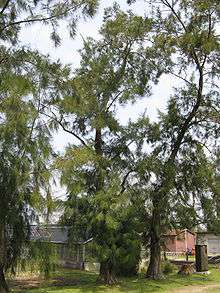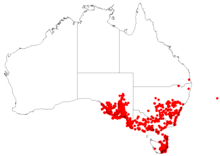Allocasuarina verticillata
| Allocasuarina verticillata | |
|---|---|
 | |
| Scientific classification | |
| Kingdom: | Plantae |
| Clade: | Angiosperms |
| Clade: | Eudicots |
| Clade: | Rosids |
| Order: | Fagales |
| Family: | Casuarinaceae |
| Genus: | Allocasuarina |
| Species: | A. verticillata |
| Binomial name | |
| Allocasuarina verticillata (Lam.) L.A.S.Johnson | |
 | |
| Occurrence data from AVH | |
| Synonyms[1] | |
| |
Allocasuarina verticillata, commonly known as drooping she-oak or drooping sheoak, is a nitrogen fixing native tree of southeastern Australia.[2][3] Originally collected in Tasmania and described as Casuarina verticillata by French naturalist Jean-Baptiste Lamarck in 1786, it was moved to its current genus in 1982 by Australian botanist Lawrie Johnson.[4]
The 1889 book 'The Useful Native Plants of Australia records common names of the plant included "Shingle Oak," "Coast She-oak," " River Oak," " Salt-water Swamp Oak" and was called "Worgnal" by the Indigenous people of the Richmond and Clarence River areas of New South Wales.It also records that, "In cases of severe thirst, great relief may be obtained from chewing the foliage of this and other species, which, being of an acid nature, produces a flow of saliva—a fact well-known to bushmen who have traversed waterless portions of the country. This acid is closely allied to citric acid, and may prove identical with it. Children chew the young cones, which they call "oak apples."[5]
It grows as a small tree with a rounded habit, reaching 4–10 metres (12–35 ft) in height.
The species occurs in Australian Capital Territory, New South Wales, South Australia, Tasmania, and Victoria.[4]
On Kangaroo Island, it is the preferred food item of the Glossy Black Cockatoo, which holds the cones in its foot and shreds them with its powerful bill before removing the seeds with its tongue.[6]
| Wikimedia Commons has media related to Allocasuarina verticillata. |
References
- ↑ "Synonyms of drooping she-oak (Allocasuarina verticillata)". Encyclopedia of Life. Retrieved 2014-04-05.
- ↑ "Common names for drooping she-oak (Allocasuarina verticillata)". Encyclopedia of Life. Retrieved 2014-04-05.
- ↑ "Allocasuarina verticillata". Retrieved 2008-10-26.
- 1 2 "Allocasuarina littoralis (Salisb.) L.A.S.Johnson". Australian Plant Name Index. Australian National Botanic Gardens. Retrieved 2014-03-29.
- ↑ J. H. Maiden (1889). The useful native plants of Australia : Including Tasmania. Turner and Henderson, Sydney.
- ↑ Crowley, GM; Garnett S (2001). "Food value and tree selection by Glossy Black-Cockatoos Calyptorhynchus lathami". Austral Ecology. 26 (1): 116–26. doi:10.1046/j.1442-9993.2001.01093.x.